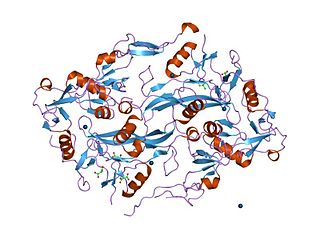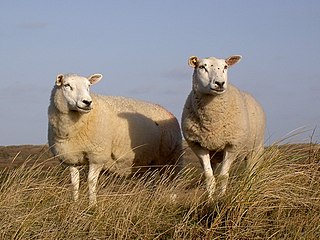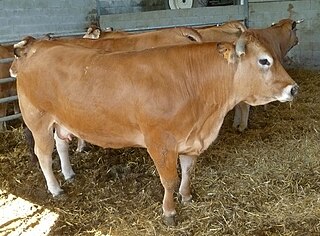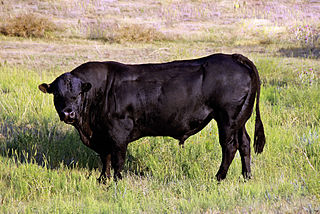Related Research Articles

The Belgian Blue is a breed of beef cattle from Belgium. It may also be known as the Race de la Moyenne et Haute Belgique, or dikbil. Alternative names for this breed include Belgian Blue-White; Belgian White and Blue Pied; Belgian White Blue; Blue; and Blue Belgian. The Belgian Blue's extremely lean, hyper-sculpted, ultra-muscular physique is termed "double-muscling". The double-muscling phenotype is a heritable condition resulting in an increased number of muscle fibres (hyperplasia), instead of the (normal) enlargement of individual muscle fibres (hypertrophy).

Myostatin is a protein that in humans is encoded by the MSTN gene. Myostatin is a myokine that is produced and released by myocytes and acts on muscle cells to inhibit muscle growth. Myostatin is a secreted growth differentiation factor that is a member of the TGF beta protein family.

Kobe beef is Wagyu beef from the Tajima strain of Japanese Black cattle, raised in Japan's Hyōgo Prefecture around Kobe city, according to rules set out by the Kobe Beef Marketing and Distribution Promotion Association. The meat is a delicacy, valued for its flavour, tenderness and fatty, well-marbled texture. Kobe beef can be prepared as steak, sukiyaki, shabu-shabu, sashimi, and teppanyaki. Within Japan, Kobe is one of the three Sandai Wagyū, the "three big beefs", along with Matsusaka beef and Ōmi beef or Yonezawa beef.

The South Devon is a British breed of large beef cattle. It originated in the counties of Devon and Cornwall in south-west England, and is mentioned from the eighteenth century. It was a dual-purpose breed, kept both for its milk and for beef. Since 1972 selection has been for beef only.

The Limousin, French: Limousine, is a French breed of beef cattle from the Limousin and Marche regions of France. It was formerly used mainly as a draught animal, but in modern times is reared for beef. A herd-book was established in France in 1886. With the mechanisation of agriculture in the twentieth century, numbers declined. In the 1960s there were still more than 250 000 head, but the future of the breed was not clear; it was proposed that it be merged with the other blonde draught breeds of south-western France – the Blonde des Pyrénées, the Blonde de Quercy and the Garonnaise – to form the new Blonde d'Aquitaine. Instead, a breeders' association was formed; new importance was given to extensive management, to performance recording and to exports. In the twenty-first century the Limousin is the second-most numerous beef breed in France after the Charolais. It is a world breed, raised in about eighty countries round the world, many of which have breed associations.

Follistatin, also known as activin-bindings protein, is a protein that in humans is encoded by the FST gene. Follistatin is an autocrine glycoprotein that is expressed in nearly all tissues of higher animals.

The Fleckvieh is a breed of dual-purpose cattle suitable for both milk and meat production. It originated in Central Europe in the 19th century from cross-breeding of local stock with Simmental cattle imported from Switzerland. Today, the worldwide population is 41 million animals.

Beef cattle are cattle raised for meat production. The meat of mature or almost mature cattle is mostly known as beef. In beef production there are three main stages: cow-calf operations, backgrounding, and feedlot operations. The production cycle of the animals starts at cow-calf operations; this operation is designed specifically to breed cows for their offspring. From here the calves are backgrounded for a feedlot. Animals grown specifically for the feedlot are known as feeder cattle, the goal of these animals is fattening. Animals not grown for a feedlot are typically female and are commonly known as replacement heifers. While the principal use of beef cattle is meat production, other uses include leather, and beef by-products used in candy, shampoo, cosmetics, and insulin.

The Texel is a Dutch breed of domestic sheep originally from the island of Texel. It is a heavy and muscular sheep, and produces a lean meat carcass. It is polled, clean-faced and clean-legged, with white face and wool. The fibre diameter of the wool averages about 32 μ, with a staple length of 8–15 cm; it is used mainly for knitting and hosiery wools.

The Piedmontese is a breed of domestic cattle that originated in the region of Piedmont, in north-west Italy. The calves are born fawn coloured, and turn grey-white as they mature. Piedmontese cattle carry a unique gene mutation identified as an inactive myostatin allele that causes hypertrophic muscle growth, or double muscling. Purebred Piedmontese cattle are homozygous, meaning they have two identical alleles present for this unique gene. They have garnered attention from breeders of beef cattle in other parts of the world, including North and South America. A small group of select Piedmontese bulls and cows were imported into Canada in the late 1970s, and into the United States in the early 1980s, and were used as the foundation breeding stock to develop a new breed of beef cattle known as North American Piedmontese cattle.

Growth differentiation factor 11 (GDF11), also known as bone morphogenetic protein 11 (BMP-11), is a protein that in humans is encoded by the growth differentiation factor 11 gene. GDF11 is a member of the Transforming growth factor beta family.

The Australian Charbray is an Australian breed of cattle derived from a cross between the French Charolais cattle and American Brahman cattle. The charbray breed was first conceived in the United States of America in the 1930s and later introduced into Australia in 1969. In Australia, Australian charbray breeders are concentrated in the tropical Northern regions of Queensland. As of 1977, the official breeder society of Charbray cattle in Australia and New Zealand is the Charbray Society of Australia Limited, responsible for recording Charbray cattle in herd books, fostering improvement, enhancement and sales of Charbray cattle.

The Parthenaise is a French breed of beef cattle. It is named for the town of Parthenay in the département of Deux-Sèvres, in the Nouvelle-Aquitaine region of western France. It was formerly a triple-purpose breed, raised for milk, meat and draught work, but is now raised mainly for beef.

The Charollais is a breed of domestic sheep originating in east central France, in the same region in which Charolais cattle originated, Charolles and Saône-et-Loire. It is known for ease of lambing and is used as a terminal sire to increase muscling and growth rate of the lambs. It has been exported internationally, and is commonly used in the United Kingdom as a sire to produce market lambs from pure-bred ewes and mules.
Myostatin-related muscle hypertrophy is a rare genetic condition characterized by reduced body fat and increased skeletal muscle size. Affected individuals have up to twice the usual amount of muscle mass in their bodies, but increases in muscle strength are not usually congruent. Myostatin-related muscle hypertrophy is not known to cause medical problems, and affected individuals are intellectually normal. The prevalence of this condition is unknown.
Expected progeny differences (EPD) are an evaluation of an animal’s genetic worth as a parent. They are based on animal models which combine all information known about an individual and its relatives to create a genetic profile of the animal’s merits. These profiles are then compared to other individuals of the same breed.

North American Piedmontese cattle are a breed of domestic beef cattle originating from an imported herd of select Italian purebred Piedmontese cattle. The foundation line of breeding stock was first imported from Italy into Canada in 1979, and into the United States in the early 1980s. Piedmontese cattle are distinguished by a unique, naturally occurring gene identified as the myostatin allele mutation, or inactive myostatin gene. Myostatin prohibits muscle growth whereas an inactive gene has the opposite effect. Purebred Piedmontese are homozygous,, which means they have two identical alleles present for this unique gene. Research indicates the presence of the myostatin allele mutation produces morphological characteristics unique to the breed, such as double-muscling, beef tenderness, reduced fat content and high yield. According to the North American Piedmontese Association (NAPA), they are the first breed registry to base animal registration requirements on the presence of this specific gene which can be easily verified by DNA testing.

The Bleue du Nord is a French breed of dual-purpose cattle from the former region of Nord-Pas-de-Calais in the north-east of the country, on the border with Belgium. It shares the origins of the Belgian Blue, but unlike that breed is selectively bred both for meat and for dairy use. The double-muscling characteristic of the Belgian Blue, caused by a genetic myostatin deficiency, is present also in the Bleue du Nord, but to a limited and controlled extent.
The Dutch Improved Red Pied, Dutch: Verbeterd Roodbont, is a recently-developed Dutch breed of beef cattle. It derives from the dual-purpose Meuse-Rhine-Issel breed, and is characterised by a high incidence of the double-muscling gene. A breed association was started in 1988.
Myostatin inhibitors are a class of drugs that work by blocking the effects of myostatin, which inhibits muscle growth. In animal models and limited human studies, myostatin inhibitors have increased muscle size. They are being developed to treat obesity, sarcopenia, muscular dystrophy, and other illnesses.
References
- ↑ Swatland, Howard (January 1974). "Developmental disorders of skeletal muscle in cattle, pigs and sheep". The Veterinary Bulletin. 44 (4): 187–189 – via ResearchGate.
- ↑ "Agriculture and Forestry". www.alberta.ca.
- ↑ "Breeds of Livestock - Belgian Blue Cattle — Breeds of Livestock, Department of Animal Science". afs.okstate.edu. 10 March 2021.
- 1 2 Glass, David J; Spiegelman, Bruce M (7 June 2012). "Se-Jin Lee, myostatin discoverer, elected to the National Academy of Science". Skeletal Muscle. 2 (1): 11. doi: 10.1186/2044-5040-2-11 . PMC 3514131 . PMID 22676848.
- ↑ Colker, Carlon. "New Muscle Drugs Could Be The Next Big Thing In Sports Doping". NPR.
- ↑ Bailey, Mears, & Mir
- 1 2 Fiems, Leo O. (20 September 2012). "Double Muscling in Cattle: Genes, Husbandry, Carcasses and Meat". Animals. 2 (3): 472–506. doi: 10.3390/ani2030472 . PMC 4494293 . PMID 26487034.